Hello. This is Omura from the editorial department.
It has been six months since I left Kamiyama Town in Tokushima Prefecture, where I spent six months as a student. Just when Kamiyama was starting to seem a little far away, I had the opportunity to go there again for the first time in a long time.
It is the planting of "Monosasu rice".
Last November, Monosasu rice was distributed to guests at Monosasu's anniversary party, and this year, the group decided to grow it from scratch.

Last year, most of the work up to the completion of the crops was done by members of the Food Hub Project (hereinafter referred to as Food Hub), led by our agricultural chief, Shiramomo. However, this year we plan to involve Monosas members as much as possible, discussing things such as what farming methods to use.
This time, we will tell you about rice planting, which is a typical example of this.
A rainy season with record water shortages...
In the midst of all this, rice planting at Monosasushi Rice
In late June, members living in Kamiyama, members from Yoyogi who were doing satellite work, and their children participated in a rice planting event.
Our team members work hard every day creating and operating websites. Usually they spend their days facing a computer, but today they are working under the sun.
Although I helped out a little with weeding and harvesting rice during the Monosasu Juku last year, this was my first time planting rice.
Rice cultivation involves planting rice, then harvesting it... I think I have a vague understanding of the basic steps, but in reality, I don't know what it actually involves.
We started by asking ourselves, "What should I wear when planting rice?"
While I was wondering if I should buy rice planting boots or go barefoot, I was told to wear socks. In the end, I decided to go with socks and plenty of sun protection.
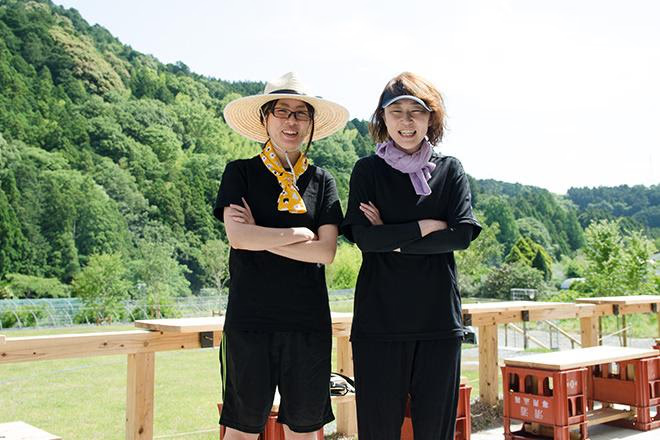
Members from Yoyogi came to Kamiyama for satellite work. They were in high spirits, wearing straw hats they had bought locally and towels with rice ball designs around their necks!
The rice field is one of the terraced fields in Oono, Kamiyama Town, which is also a producer of sudachi citrus.
Our instructor will be Food Hub's agricultural instructor, Kaoru Shiramomo.

Mr. Shirato giving an explanation. A handsome farmer and town hall employee (according to Food Bub manager)
First, we were given an explanation about the rice planting.
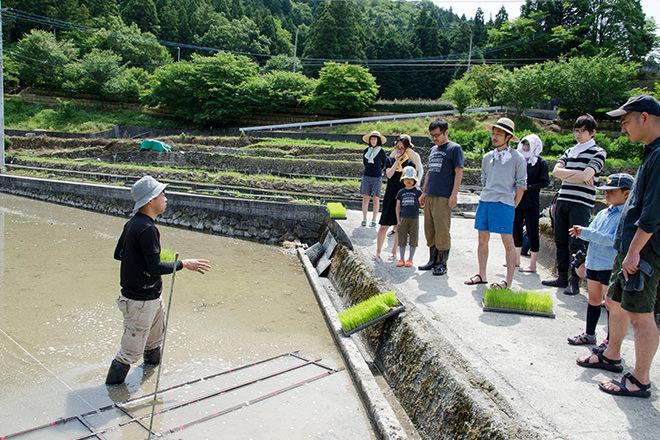
The rice field is 4 acres in size.
This is the first time I've heard of this unit.
One ridge is 10m x 10m, or about 100m2 in area, which is roughly the same size as 1a (are).
So, 4 acres is about 400 square meters.
By the way, one ridge is roughly 30 paces long.

A rice field measuring 4 acres in size
And 10 acres = one tan.
I've heard of the expression "tan (a tan) of rice field."
It is expected that about 100 kg can be harvested from 4 acres.
The variety to be planted is "Ikuhikari."
They provided us with seedlings that had been left to germinate for about two weeks from unthreshed rice grains harvested last year.
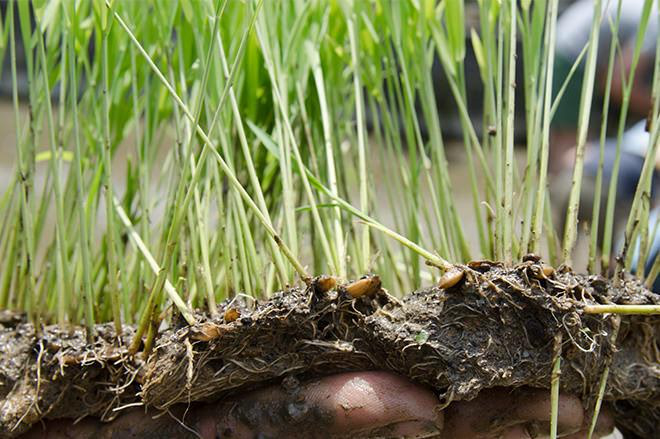
Germinated rice
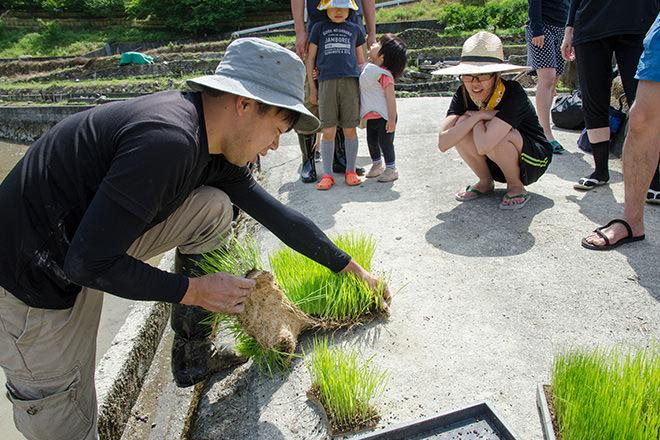
We tear off the seedlings and throw them into the rice fields.
This time, before planting, the soil was tilled with oil cake, which is the residue left over from making rapeseed oil, and water was added the day before. However, this year's rainy season has brought about an unusual water shortage, so the work had to be done with little water.
Now, let's start planting!
At first, everyone was hesitant to go into the rice field.
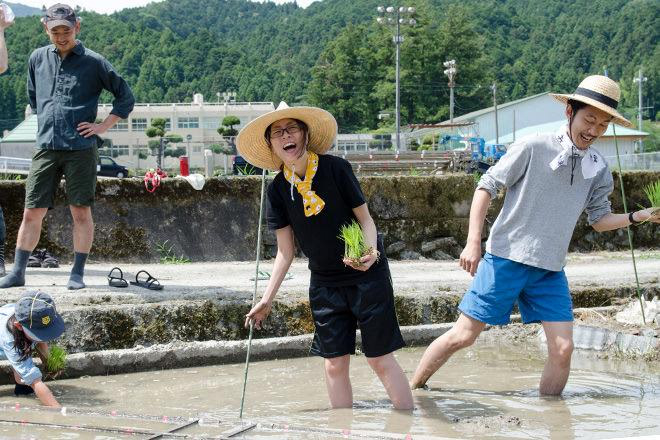
When I entered the rice field, I couldn't help but shout out
Once you get in, you'll find yourself in a surprisingly pleasant muddy environment.
Two or three seedlings are pinched off and planted in one place.
This time, we will plant by hand, so we will use a large ruler for hand planting. The rulers are a collection of things that the Hakuto family has used for a long time, as well as things that are no longer in use in the area. It is important that the spacing is even, considering that in the future, we will be able to use machines to efficiently weed and harvest the plants.
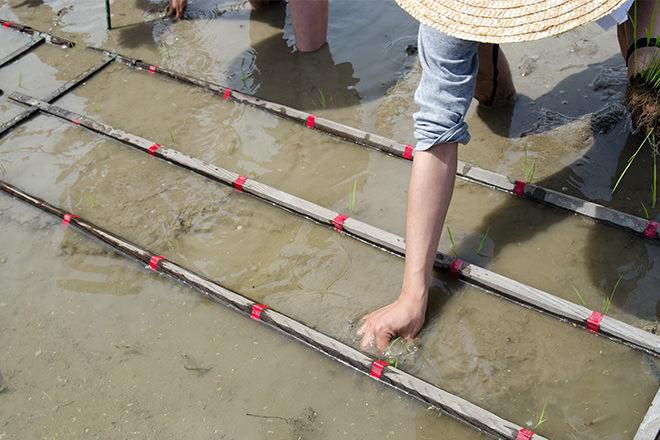
A ruler for hand planting. Plant the seedlings where the red marks indicate...

Flip it over in the direction of travel. Repeat this process repeatedly, matching the pace with the person next to you.
We all coordinate our pace and when we have finished planting on the marks on the ruler, we all flip the ruler over in the direction we were moving forward.
Along the way, we had trouble getting our feet out of the mud, and people started shouting, "There's something in the mud!"
We were all a bit nervous because we had heard there might be leeches, but luckily no one encountered any that day.
Working while squatting for a long time is quite tough.
While the adults were taking a break, the children continued to work efficiently and silently.

The children (the two in the middle) worked silently without a break.
As I worked, I was reminded of the flower planting I saw in Hiroshima, my hometown.
After the cows dig up the soil in the rice fields, the young women plant the rice while singing to the beat of drums. On this day, both the cows and the young women are dressed up in gorgeous attire. This event is held to pray for good health and a bountiful harvest.
I don't remember what songs we sang, but I realized for the first time while planting the rice that singing along with the others must have made the monotonous work more enjoyable.

It took about an hour and a half to work.
Rice planting on 4 acres is complete!
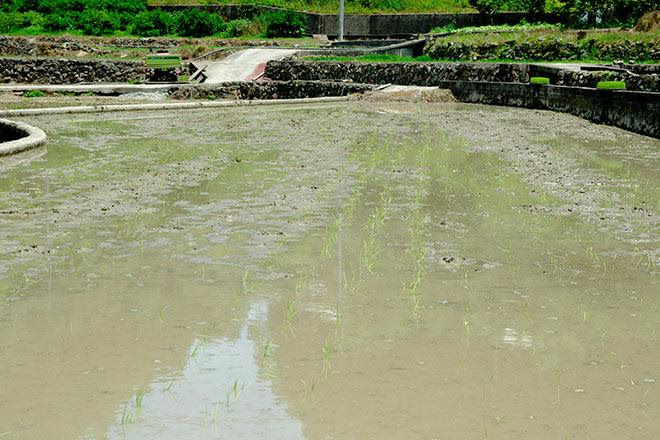
Some members lost their socks along the way, but I'm sure they'll find them somewhere at some point.
Perhaps it was because they had come into contact with the soil or the fresh air in Kamiyama, but the members who participated seemed more energetic than before the work began.

A sense of accomplishment, perhaps, and a relieved expression
The participants shared their impressions with a clear look on their faces, saying things like, "Using a ruler was a good idea," "It was unexpectedly difficult to separate the seedlings in pairs," and "Planting rice was more fun than I thought it would be!" One member even said that after planting rice, they felt more motivated!
On this day, after finishing rice planting, we had lunch at Kamaya.
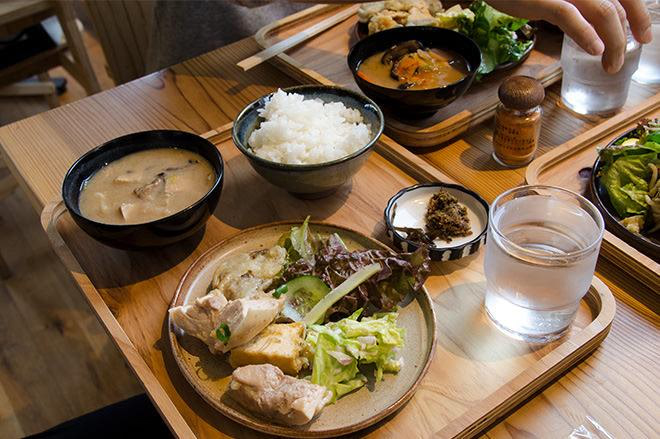
It may seem obvious, but this rice is only harvested because of rice planting.
The rice tasted even more delicious.

Let's all eat together
Kamiyama has a large temperature difference between day and night, which makes the rice especially delicious.
I'm looking forward to the harvest.
The future of Monosasushi rice
From now on, Hakumomo will start checking the moisture level in the rice paddies almost every day.
Depending on the weather, the amount of water in the rice fields can change significantly throughout the day as it evaporates into the air or is absorbed by the soil. It is important to keep an eye on the water levels to ensure they remain constant.
In addition, water is poured into the rice fields in the morning and then heated by sunlight from midday until evening. This helps the rice grow better.
However, this year's rainy season has seen little rain. They are concerned about the amount of water that can be brought in. They say that the amount of work to be done, such as weeding, will depend on whether it rains within a week after rice planting.
Naturally, if there is less rain and there is less water, less water will be drawn from nearby rivers.
Also, in terraced fields like the Monosasu rice we are growing in this time, water is more likely to run off than in rice paddies on flat land.
And if you choose a method that uses fewer pesticides, weeding is essential.
After planting, a task called "weeding" is required to mix the grass and soil together to prevent unwanted weeds from sprouting.
If the weeds are not pulled out once every 10 days, they will absorb the nutrients that would otherwise go to the rice, resulting in a lower yield.
Will I have to use herbicides or do it by hand?
In the future, we will discuss and decide on such matters as whether to use pesticides, whether to harvest mechanically, and whether to use hazekake (drying the rice in the sun after harvesting).
Naturally, the more care you take, the closer it will be to nature and the better the taste will be. The yield also depends on whether there is enough nutrition for the rice to grow, not on weeds.
I would like to get not only the members in Kamiyama, but also as many members in Yoyogi as possible involved by doing satellite work in Kamiyama.
One of the purposes of Monosasu Rice is to allow members to experience rice farming, but it also includes the theme of how Monosasu can contribute to agriculture as a company .
Regardless of the yield, farmers will contract rice fields for a fixed amount per year and choose their farming methods together with the food hub, sharing the risks. By sharing risks in this way, we hope to increase the number of new farmers, even if only a little, and contribute to sustainable agriculture.
However, once we use the machines, this rice planting can actually be completed in just 15 minutes.
And weeding and harvesting can be done in no time if we use machines. Forcing us to do the work by hand and receiving instruction just so that we can experience rice farming is very inefficient and actually makes the farmers take more time and effort.
How can a company commit itself to sustainable agriculture?
We are still exploring.
From now on, the rice will continue to grow without any problems.
I hope to be able to report on the progress of weeding and harvesting as well!
After rice planting
About half a month after rice planting
Rice fields in early July
About two weeks after the rice planting, we spoke to Shiramomo about the current state of the rice fields.

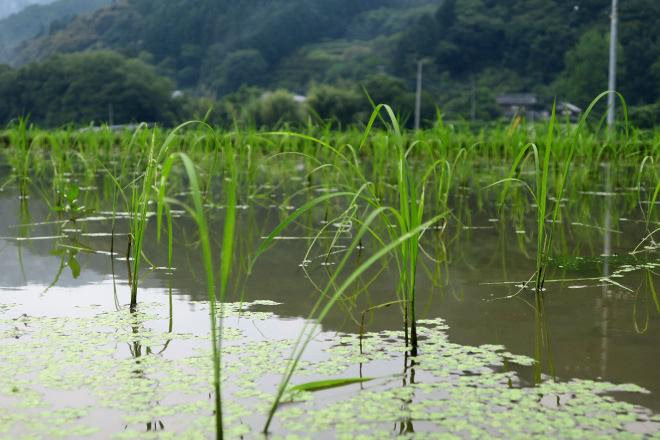
It is growing well and healthily!
After the rice planting, a typhoon came and brought rain, so the water shortage that had been a concern was completely resolved.
Some of the seedlings had not been planted properly, so they had to be replanted.
Then, out of nowhere, horseshoe crabs started appearing spontaneously, which had not been there the previous year.
There seem to be a lot of them swimming around.
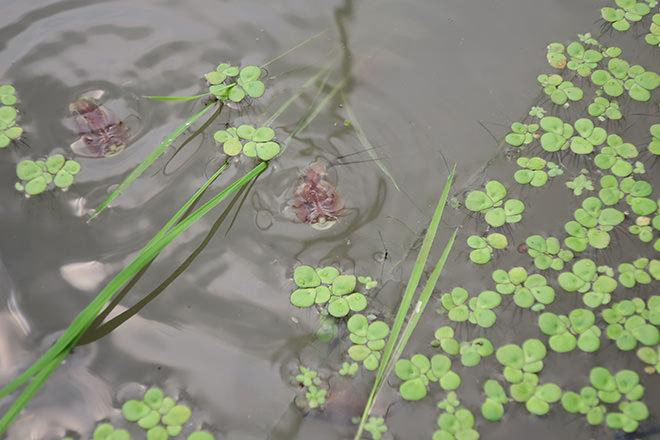
Horseshoe crabs swimming energetically through the rice fields
Shrimp?! Are they okay? Well, it turns out that the shrimp stir up the water, which mixes up the soil and makes it harder for grass to grow. Because of this, the weeding that was previously required 10 days after planting is no longer necessary, and only water management is required.
Thank you, horseshoe crabs.
About one month after planting
Late July rice
I wonder if Shiratoo will contact me soon about weeding?
I waited and waited, but July passed without any contact.
As we approach the second half of July, we asked about the state of the rice fields.
To my surprise, the answer I got was unexpected.
This year, after planting, there has been no need to weed at all!
When I was in Kamiyama last year, I heard a lot of stories about how hard it is to weed when farming rice, so I was curious how something so miraculous could have happened!?
We asked Shiramomo-san, "What do you think?"
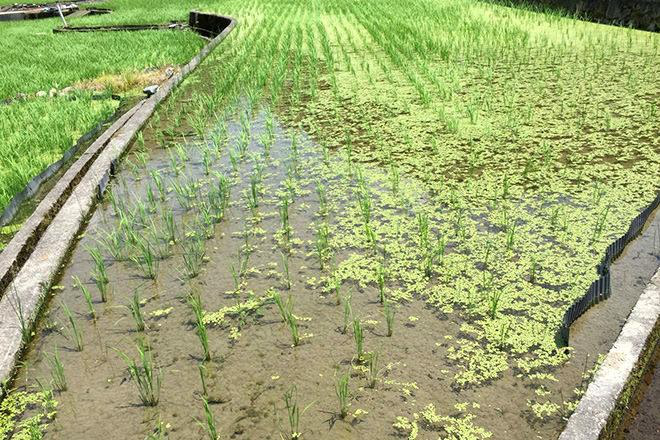
The state of the rice field in late July. The roots have taken hold and the rice is growing rapidly. Compared to other rice fields, there is apparently very little grass growing here!
In fact, this year they experimented by spreading something called "rice bran compost" after planting the rice.
"Rice bran bokashi" is made by adding bacteria to rice bran and rice husks and fermenting them.
This time, they used "rice bran compost" fermented with EM bacteria, which contain microorganisms such as lactic acid bacteria and yeast. (EM stands for Effective Microorganisms .)
And this "rice bran bottling" has two effects that make it difficult for weeds to grow in the rice paddies.
One reason is that fungi and microorganisms cover the surface of the rice field soil with a sludgy layer, burying weed seeds deep in the soil and preventing them from sprouting.
Another reason is that organic acids such as acetic acid are produced during fermentation by microorganisms and bacteria, and these organic acids make it difficult for new weed shoots to grow.

Apparently, the floating plants on the water surface are not a problem for the growth of rice. When I hear that, I find the bright green rice fields very beautiful.
Rice bran, bacteria, and shrimp. The power of nature is currently supporting the growth of this rice.
I'll report back to see how the Monosasu rice grows from now on!

